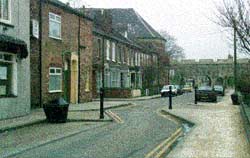Ok I realize I'm commenting on this a full 11 years after the article was written, and surely there's been some improvement in the science since. Still, I will take my web2.0 privileges and offer my 2c worth.
-speed bumps are not effective, they're bloody annoying
-obstacles like massive flowerpots are dangerous in that they hide children/vehicles from each other
-zigzag configurations are an interesting challenge to test your handling limits
-traffic lights for crosswalks that are calibrated for herds of paraplegics are extremely irritating and make drivers resent pedestrians even more
I've travelled many states, provinces and countries, and find that systems that allow drivers and pedestrians to coexist and self-reglate (rather than compete with each other or blame each other for dangers/delays) are the most effective. Kinda like roundabouts, make it clear who has priority (e.g., highly visible chokepoints with crosswalks at pedestrian friendly locations) and let traffic flow on its own otherwise.
Traffic calming: theory and practice
By: Drivers.com staff
Date: Thursday, 22. October 2009
In theory, it something works like this. If the road is open and clear it's an invitation to drivers to speed up-and they will, unless there's very heavy enforcement of lower speed limits. But give drivers a complicated roadway environment, appropriately designed with narrower not-so-straight lanes, leafy overhanging trees, shrubs and flowers planted close to the lanes, varied surfaces and suitable road markings, and they'll drive appropriately slow, even if there's no enforcement.
In practise, there are problems, both with the techniques of calming and with the process by which they become part of a traffic plan.
 Traffic
calming techniques are based on the idea that drivers subconsciously respond
to cues in the roadway environment when adjusting their speed, and traffic
engineers have a basketful of tricks for providing those cues. However, very
little is known about the specifics of how drivers interact with these techniques
and how they are best used together.
Traffic
calming techniques are based on the idea that drivers subconsciously respond
to cues in the roadway environment when adjusting their speed, and traffic
engineers have a basketful of tricks for providing those cues. However, very
little is known about the specifics of how drivers interact with these techniques
and how they are best used together.
In short, there's a lack of research. If drivers subconsciously slow for some cues, they may speed up for others. A stop sign will be less effective if its message is surrounded by visual cues that say "go" to the driver's subconscious mind. A traffic calming project is headed for trouble if drivers are getting conflicting messages from the road environment, so engineers need to know what cues drivers react to and how effectively they work.
"There's a lot of work going on in this area," says Genny Bahar, a Canadian consultant who is currently working on a manual for traffic engineers on behalf of the Transportation Association of Canada. Bahar sees her job as one of bringing the results of research to engineers working in the field. "At the end of the day," says Bahar, " if we designed right, nobody would talk about traffic calming. Everyone would know it's a residential area, a business area or a traffic artery...When you do it wrong the first time and then change it you create a controversy."
Part of the problem now, she points out, is that traffic engineers are traditionally trained to improve the efficiency and flow of traffic, but now they're being asked to do something different. In Canada and the U.S. says Bahar, engineers are presented with the task of retrofitting streets that were originally designed for faster speeds. Priority was given to motor vehicles. "Now we realize we have to share space with other road users." In the beginning, she adds, traffic calming methods were implemented in a spot manner. One street, or even part of a street might be given the treatment. "Now, engineers realize that calming must be part of a neighborhood plan."
What that means in practise is that traffic engineers must know the objectives of the project (using surveys etc.), choose measures carefully and make traffic calming a total process that's political as well as scientific. As Australian researcher Ray Brindle points out, "If drivers respond with outrageous behavior (such as driving on the sidewalk to get around speed bumps) "it's often a sign that the implementation and information programs have not been well handled."
One community that does seem to have a comprehensive process in place is Clark County in Washington state. Some jurisdictions already have pretty comprehensive approaches to calming. The County has a strategy for neighborhood traffic management that includes a point system for developing priorities. The procedure starts with citizen requests. These are developed into "petitions-to-study" which are circulated through neighborhoods and local associations. County staff help develop the petitions, and if a petition gathers momentum it winds up before a Traffic Management Advisory Committee (TMAC) and then goes on through hearings and meetings designed to ensure public support for the calming measures. A point system is used to evaluate calming requests and allocate them a priority. Factors such as traffic volume, speed, and schools are taken into account in the point system.
The TAC's manual will provide traffic engineers and planners with a well researched base of criteria and procedures for traffic calming projects. It will also, says Bahar, be useful as a text for training traffic engineers. This should avoid some of the problems which have plagued calming projects in the past and led to running battles between various interest groups.
Further comments to this article have been disabled.
All Comments (1)
Showing 1 - 1 comments
![]() crammer,
crammer,
